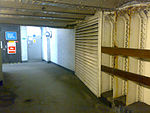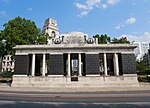Tower Subway

The Tower Subway is a tunnel beneath the River Thames in central London, between Tower Hill on the north bank of the river and Vine Lane (off Tooley Street) on the south. In 1869 a 1,340-foot-long (410 m) circular tunnel was dug through the London clay using a cast iron shield, an idea that had been patented in 1864 by Peter W. Barlow but never built.A 2 ft 6 in (762 mm) narrow gauge railway was laid in the tunnel and from August 1870 a cable-hauled wooden carriage conveyed passengers from one end to the other. This was uneconomic and the company went bankrupt by the end of the year. The tunnel was converted to pedestrian use and one million people a year crossed under the river, paying a toll of a ha'penny. The opening of the toll-free Tower Bridge nearby in 1894 caused a drop in income and the tunnel closed in 1898, after being sold to the London Hydraulic Power Company. Today the tunnel is used for water mains. The same shield method of construction was used in 1890 to dig the tunnels of the City and South London Railway, the first of London's electrified "Tube" railways and the first underground electrified railway in the world.
Excerpt from the Wikipedia article Tower Subway (License: CC BY-SA 3.0, Authors, Images).Tower Subway
Petty Wales, London Whitechapel
Geographical coordinates (GPS) Address Nearby Places Show on map
Geographical coordinates (GPS)
| Latitude | Longitude |
|---|---|
| N 51.508333333333 ° | E -0.078888888888889 ° |
Address
London Hydraulic Power Company (Tower Subway Entrance)
Petty Wales
EC3R 5BT London, Whitechapel
England, United Kingdom
Open on Google Maps








